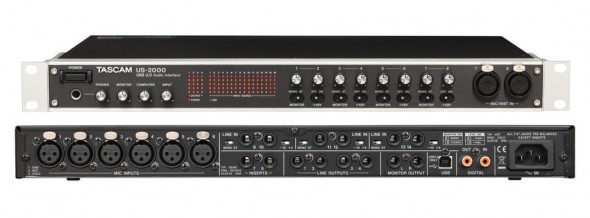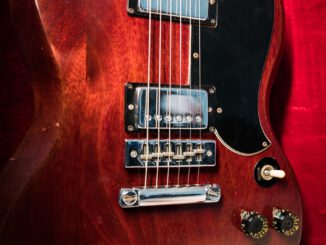 TASCAM has been making recording gear longer than most people reading this have been alive, so they know their audio processing, and they know how to design devices that successfully combine audio fidelity, build quality, and user-friendly design. Two TASCAM interfaces continue that tradition by providing low-cost recording solutions that fulfill a variety of audio and MIDI interfacing needs.
TASCAM has been making recording gear longer than most people reading this have been alive, so they know their audio processing, and they know how to design devices that successfully combine audio fidelity, build quality, and user-friendly design. Two TASCAM interfaces continue that tradition by providing low-cost recording solutions that fulfill a variety of audio and MIDI interfacing needs.
For under $300, the US-1641 will amply supply most home and project studios with all the audio and MIDI ins and outs they could ever use. Using USB 2.0 (a standard feature on every modern laptop and desktop computer), the US-1641 can bring 16 channels of high-resolution audio and 16 MIDI channels into and out of your computer. For a little more money (under $200 more), the US-2000 provides superior sonic quality and a couple of extra features, while leaving out the MIDI aspect, figuring that the prospective buyer already has at least one solution for that.
Sweet 16
Both the US-1641 and the US-2000 feature 16 inputs and four outputs of high-resolution (96kHz/24-bit) audio. This is enough to record virtually any rock, jazz, country, pop, pit orchestra, or praise & worship ensemble, and can even accommodate larger ensembles, like choirs or concert bands.
Having multiple inputs has two advantages. The most obvious one is that you can record more instruments and voices simultaneously. In my tests, I recorded a whole drum kit (five mics), a direct-injected bass, three vocal mics, and a guitar without experiencing one glitch or pop as I recorded using the included version of Cubase LE. Even if you don’t record a lot of instruments at once, having multiple inputs saves you from constantly plugging and unplugging cords. So if you’re a solitary recordist who records one or two channels at a time, a one, two, or four-input interface will have you spending considerable time connecting inputs as you switch from guitars, vocals, basses, keyboards, and other inputs. Permanent assignments for inputs not only reduce stress on the connections, they let you work faster while developing an efficient recording rhythm. Inputs on your interface are like dollar bills or vintage guitars: you can never have too many, and the 1641 and 2000 will make you rich in connectivity!
The 1641 front and center
The US-1641 sports eight front-panel XLR inputs, giving you easy access to mic inputs (or other signals that use this three-pin, bal-anced-line configuration). If you have line-level instruments—such as keyboards, and effects returns from line-level processors—you’ll find another six 1/4″ line-level jacks on the back panel. Also around back is where you’ll find the digital S/PDIF I/O in the form of two RCA jacks. (Each jack carries a stereo signal.) The S/PDIF In jack is often what you’d use for gear that outputs digitally (such as a CD player with a digital out or high-end mic preamplifier with an onboard A/D converter), thus saving a pair of analog inputs.
Additional features on the US-1641 include selectable level switches for the four 1/4″ balanced line inputs (- 10 or + 4), switchable phantom power for condenser mics, plus separate volume controls for the headphone, monitor, and mix outputs. The 2000 differs from this scheme in that it has more specific phantom power assignments and more comprehensive monitor controls that include an input level control (feeding the monitor and headphone outputs) and Mono/Stereo switches for monitoring adjacent pairs of the six line inputs ( 9-10, 11-12, 13-14).
MIDI spoken here
The US-1641 also has MIDI in and out jacks, allowing you to bring keyboards, MIDI controllers (such as floor-based MIDI pedals for guitar), and other MIDI sound modules under computer control. The US-1641 receives computer-generated, outgoing MIDI signals via its MIDI input, so you can have MIDI tracks from your DAW sending signals to any outboard MIDI gear. You can also use the MIDI I/O to transmit MIDI Time Code (MTC) from your DAW (Cubase, etc.) to synchronize with your MIDI gear.
Why 2k?
Two features are unique to the US-2000: the LED meter region on the front panel and the presence of insert jacks. The meters are comprised of five-segment LEDs for all 16 input channels plus the four outputs—a total of 100 LEDs are devoted to visual feedback, showing you the status of all your input and output levels at any given moment. Insert jacks are important if you like to strap on a dynamics processor while still in the analog domain, before going to the computer as a digital signal. For example, if you deal with many vocalists with varied levels of skill, you may want to have a compressor or limiter in the insert jack to ensure a distortion-free take—you may not get the opportunity for a redo! You don’t often find this feature in other interfaces, including some costing hundreds more than the US-2000.
Conclusion
The US-1641 and US-2000 are two outstanding solutions for interfacing any studio or live performance setup into a computer. If you’re on a budget and don’t already have a MIDI interface, the 1641 is the way to go. If you have a little more cash to spare and are looking to outfit a higher-level studio, the US-2000—with its LED meters for superior visual monitoring, Insert jacks, and more-flex-ible signal control—will give you an edge in versatility. Whichever you choose, you’ll possess a solid, reliable, compact, and great-sounding interface as your recording centerpiece.
Written by Jon Chappell
Musicians Friend





I have the US-1641. It is the single most important piece of musical equipment that I have purchased. I did away with cubase and use the US-1641 with FL Studio. Simply because I am more familiar with that. The audio quality is amazing and I am proud to say that I have ended up with some very clear sounding final mixes. Great product.